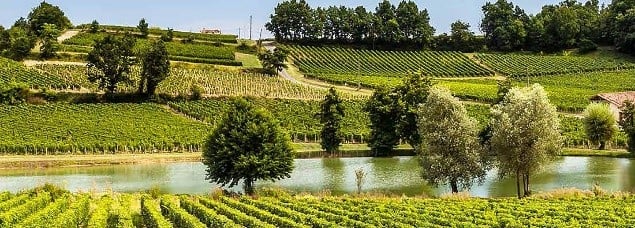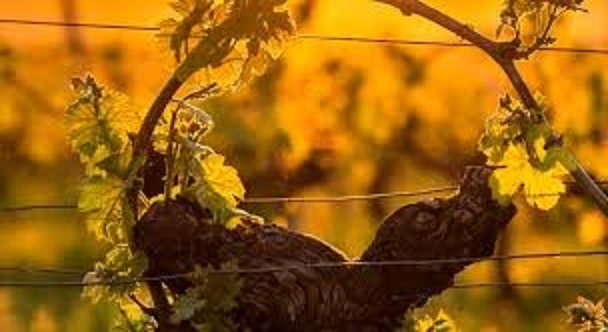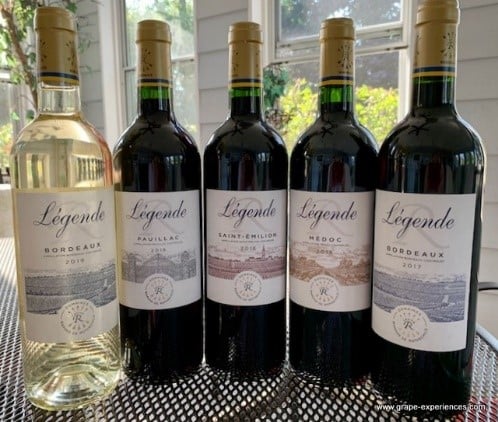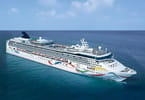- The Bordeaux region is the largest wine producing region in France and includes 280,000 acres of vines and 60 Appellations d’Origine Controlees (AOCs).
- Wine making in the southwestern portion of France started when the Romans arrived (think first century).
- Although the area is acclaimed for its red wines, it is interesting to note that this fame is newly acquired.
An Abundance of Wineries
Historically, the Bordeaux region was desirable for its (mostly) white wines with winemakers devoting more that 80 percent of their vineyards to Sauternes, Barsac, Bordeaux Blanc and Graves.
It was not until the 1700s that red wine from Bordeaux interested the marketplace and English wine enthusiasts embraced the red Bordeaux wines from Graves and named it Claret (klairette). Once the winemakers noticed the uptick in the purchase of red wines, they began to transition from white to red wine production. The transformation became official in the 1855 Classification that identified the best producers in the region, ranking them 1-5. The classification has never been modified (except once) even though there are many other outstanding wines.

To prove how popular the area is for wine making, consider the fact that the region supports 6100 chateaux owners and other growers who produce 650 million bottles of wine (2019). The 2019 vintage included 85.2 percent red; 4.4 percent rose; 9.2 percent dry white, and 1.2 percent sweet white.
Bordeaux is the major employer in viticulture and the wine industry, supplying over 55,000 direct and indirect jobs. Three out of every 4 agricultural estates in the region grow vines and in total there are 5,6000 winemakers producing AOC wine. Of these 56 percent are family-owned businesses, with an average vineyard size of 19.6ha with the biggest vineyards in Entre deux Mers and the Medoc. Approximated 5 percent of the overall vineyard surface of Bordeaux belongs to classified estates across the Left and Right banks (winescholarguild.org).
In the region, chateaux owners usually sell their grapes through a negociant who acts as a middle person by purchasing their allocations of grapes and selling / distributing the resulting wine. Of the wine produced in the Bordeaux region, 58 percent is sold within France with the remaining 43 percent exported worldwide.
Not Politics. Geography: Left, Right, Middle

The Bordeaux region is divided geographically by the Gironde estuary into a Left Bank, Right Bank and Entre-Deux-Mer (the area between the Gironde Estuary and the Dordogne River).
Left Bank. Wine lovers find Medoc, Graves and Sauternais (best terroirs – gravel based)
• Medoc features Cabernet Sauvignon; the grapes grow in a mix of clay soil and alluvial gravel terraces.
• Graves features Cabernet Sauvignon; gravelly soil due to historical glacial activity.
• Sauternais features Sauternes (sweet white wines); intense gravelly soil which enables drainage, preventing grapes from having too much water.
Right Bank. Wine lovers find Libournais, Balye and Bourg (soils dominated by clay and limestone)
• Libournais features Saint-Emilion, Montagne, Pomerol, Fronsac, Cotes de Castillon; mostly limestone, sandy and siliceous clay soil.
• Balye features Merlot, Cabernet Sauvignon and Cabernet Franc; mostly clay over limestone soil.
• Bourg features Malbec, Sauvignon Blanc, Muscadelle, and Semillon as well as Colombard and Ungi; sand, clay, gravel and limestone soils.
Entre-Deux-Mers (only white wines carry AOC appellation); Cadillac, Loupiac, Sainte-Croix-du Mont
• Cadillac (known for its sweet botrytized white wines) features Semillon, Sauvignon Blanc and Sauvignon Gris; chalky and gravelly soils.
• Loupiac features Semillon, Sauvignon Blanc, Muscadelle and Sauvignon Gris; clay, limestone soil composed of gravels and clay.
• Sante-Croix-du Mont features Semillon, Muscadelle, and Sauvignon; clay, limestone soil.
The white Bordeaux wines are usually made with Sauvignon Blanc and Semillon and are noted as being lively and fresh (Entre-Deux-Mers) to soft and citrus-like (Pessac-Leognan).
The red wines from Bordeaux are typically medium-full-bodied with the scent of black currants, plums and earth or wet gravel. On the palate, the flavor profile includes minerality, fruit and spice, delivering lots of tannins (good for ageing).
The red Bordeaux is usually a blend with labels stating the wine’s appellation rather than the specific grape variety included. White varieties comprise the remaining 100 percent of vines planted, with 5 percent Sauvignon Blanc and Semillon with one percent Muscadelle and other whites.
Of the vines planted in the region, 89 percent are red varieties, 59 percent Merlot, 19 percent Cabernet Sauvignon, 8 percent Cabernet Franc and the final two percent include Petit Verdot, Malbec or Carmenere.
Whether the Weather

The Bordeaux vines enjoy long, warm summers, a wet spring and fall, followed by moderate winters. La Foret des Landes, a large forest of pine trees, protects the Bordeaux region from the maritime climate influences of the Atlantic Ocean; however, climate change is impacting the region and effecting yields. The Institut National de l’origine et de la Qualite (INAO), a division of France’s Ministry of Agriculture, spent a decade researching climate change. Wine scientists and growers in Bordeaux seriously consider the impact of global warming and recently approved new varieties well-suited to alleviate the hydric stress associated with temperature increases and shorter growing cycles.
In June, 2019, the Bordeaux and Bordeaux Superieur Associations approved the addition of seven new disease and heat-resistant grape varieties and this represents the first amendment to the region’s original 13 varieties since 1935. The seven new approved varieties include red (Marselan, Touriga Nacional, Castets, Arinarnoa), and white (Alvarinho, and Lilorila) with first plantings of new varieties scheduled for this year. The new varieties are limited to 5 percent of the planted vineyard area and cannot account for more than 10 percent of the final blend of any given color.
Bordeaux has introduced other enological and agricultural practices to deal with climate change including: adapting best practices to the needs of each vintage – delayed pruning, increasing vine trunk height to reduce leaf area; limiting leaf-thinning to protect grapes from the sun; adapting pot sites to minimize hydric stress (permanently or seasonally saturated by water resulting in anaerobic condition); night harvesting and reducing plant density.
Sustainable
More than 65 percent of the Bordeaux vineyards are certified environmental (a new yardstick for the region). Bordeaux leads all French AOPs in volume of High Environmental Value (HVE) certifications for their wineries, having reached the top level of sustainable certification in France and a 30 percent increase in organic agriculture.
Winemakers in Bordeaux share a collective vision and commitment to proactively address climate change by preserving scarce water and energy resources; protecting fragile ecosystems; and supporting biodiversity from best vineyard practices to alternative packaging. The commitment to sustainability includes attention to enhancing worker safety, job satisfaction and training and development/training for current and future generations.
Important Wine Chateau in Bordeaux
Domaines Barons de Rothschild (Lafite) Les Legendes Makes Fine Wines Affordable

The wine histories of Lafite and Latour spans centuries. The first time the Lafite name appears dates back to the 13th century (1234) when Gombaud de Lafite, an abbot of the Vertheuil Monastery (north of Pauillac) is mentioned. The name Lafite comes from the Gascon language term “la hite” or hillock.
It is surmised that vineyards were already on the property when the Segur family organized the vineyard in the 17th century and Lafite began to be known as a great winemaking estate. In the 18th century Lafite began to explore the London market and was noted in the London Gazette (1707) describing the wine as the New French clarets. Robert Walpole, the Prime Minister, purchased a barrel of Lafite every three months. The French interest in the wines of Bordeaux did not begin until many years later following in the footsteps of the Brits.
During the 18th century Marquis Nicolas Alexandre de Segur improved the winemaking techniques and enhanced the prestige of fine wines in foreign markets and especially at the Court of Versailles. Known as “The Wine Prince,” Lafite became The Kings Wine with the support of an able ambassador, the Marechal de Richelieu. When Richelieu was appointed Governor of Guyenne, he consulted a Bordeaux doctor who advised him that Chateau Lafite was, “the finest and most pleasant of all tonics.” When Richeliu returned to Paris, Louis XV told him, “Marechal, you look twenty-five years younger than you did when you left for Guyenne.” Richeliu claimed he found the Fountain of Youth with Chateau Lafite’s wine which as, “delicious, generous, cordial, comparable to the ambrosia of the Gods of Olympus.”
Lafite had excellent publicity at Versailles and he received the King’s approval. Everyone now wanted the Lafite wines and Madame de Pompadour presented it with her supper receptions and Madame du Barry served the King’s Wine exclusively.
The treasured Bordeaux wines of French aristocracy (Domaines Barons de Rothschild/Lafite) are available to us through the Legende brand.

1. Legende Medoc 2018. 50 percent Merlot, 40 percent Cabernet Sauvignon, 10 percent Petit Verdot. Partly aged in oak for 8 months giving notes of vanilla and smoky undertones.
The eye is delighted with the intense red hue while the nose is entertained with the courageous fragrance of sweet spice, red fruits, a mix of sweet, bitter, salty and sour (think licorice), enhanced by notes of mocha and toast from barrel ageing. The taste lingers on the palate presenting an experience that is agile and flavorful delivering freshness on the finish. Pair with beef, lamb, venison, or poultry.
2. Legende R Pauillac 2017. 70 percent Cabernet Sauvignon, 30 percent Merlot. Sixty percent aged in French oak for 12 months.
The first sight impression of this deep purple wine with hints of black suggest it will be sophisticated and discreet. The nose discovers a fine bouquet of spice, raspberry jam, vanilla and flint happily mingling together. Self-confident on the palate, it delivers traces of black fruit, coconut, and vanilla with coated tannins. This is a full-bodied wine and that makes a bold statement. Pair with beef steak, stew, matured cheeses such as Comte and Saint Netaire.
3. Legende Saint-Emilion 2016. 95 percent Merlot, 5 percent Cabernet Franc (from Libourne subregion). Forty percent aged in French oak barrels.
The first look at this wine presents a shiny black cherry red hue. The nose is happy when it finds licorice, plums, cherries, woodchips and tobacco. The palate is rewarded with suggestions of mocha, herbs, cloves, perfume, old wood and a rich tannin structure. Pair with duck or game terrine and quince jelly, shoulder of lamb roasted with rosemary or thyme, pizza and pasta napolitana or lasagna.
4. Legende R Bordeaux Rouge 2018. 60 percent Cabernet Sauvignon, 40 percent Merlot.
Aged 9 months in concrete vats and 60 percent of the final blend aged in barrels.
Crimson to the eye with the red fruit and blackberries, licorice and sweet spice seducing the nose, especially keen as the scent of mocha and toast from barrel aging chime in to the experience. Fresh and fruity on the palate, the finish is pleasantly fruity. Pair with risotto with meat sauce, pasta Bolognese, ham and salami.
5. Legende R Bordeaux Blanc 2020. 70 percent Sauvignon Blanc, 30 percent Semillon.
The eye is delighted with the palest of golden yellow with glints of straw. The nose is rewarded with suggestions of tropical fruit and hints of minerality. The palate is seduced by round and full-bodied flavors leading to a lively citrus- fresh finish. Pair with seafood, raw oysters, anything with Bearnaise sauce and a green salad (non-vinegar dressing).
© Dr. Elinor Garely. This copyright article, including photos, may not be reproduced without written permission from the author.
WHAT TO TAKE AWAY FROM THIS ARTICLE:
- In the region, chateaux owners usually sell their grapes through a negociant who acts as a middle person by purchasing their allocations of grapes and selling / distributing the resulting wine.
- It was not until the 1700s that red wine from Bordeaux interested the marketplace and English wine enthusiasts embraced the red Bordeaux wines from Graves and named it Claret (klairette).
- The Bordeaux region is divided geographically by the Gironde estuary into a Left Bank, Right Bank and Entre-Deux-Mer (the area between the Gironde Estuary and the Dordogne River).























